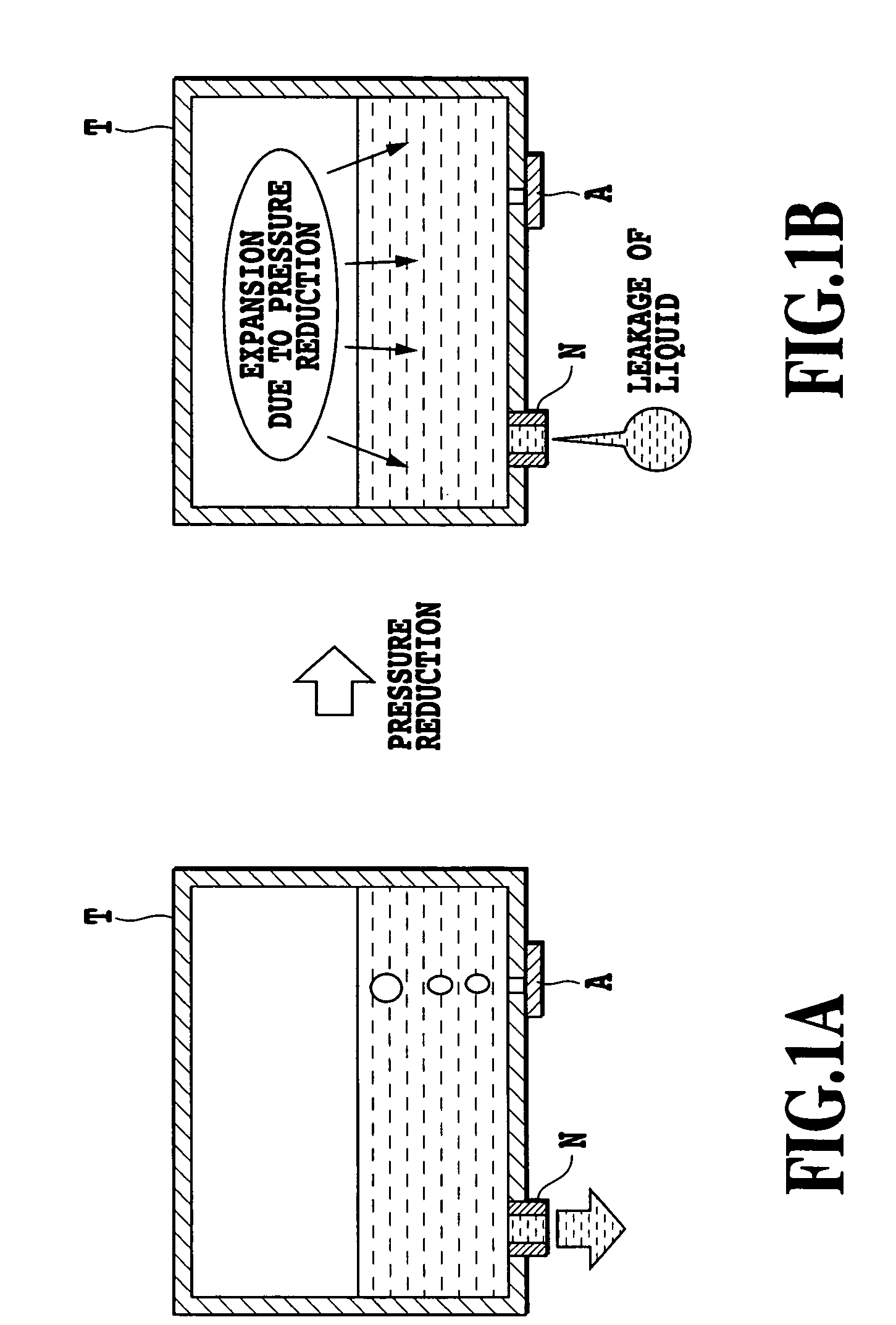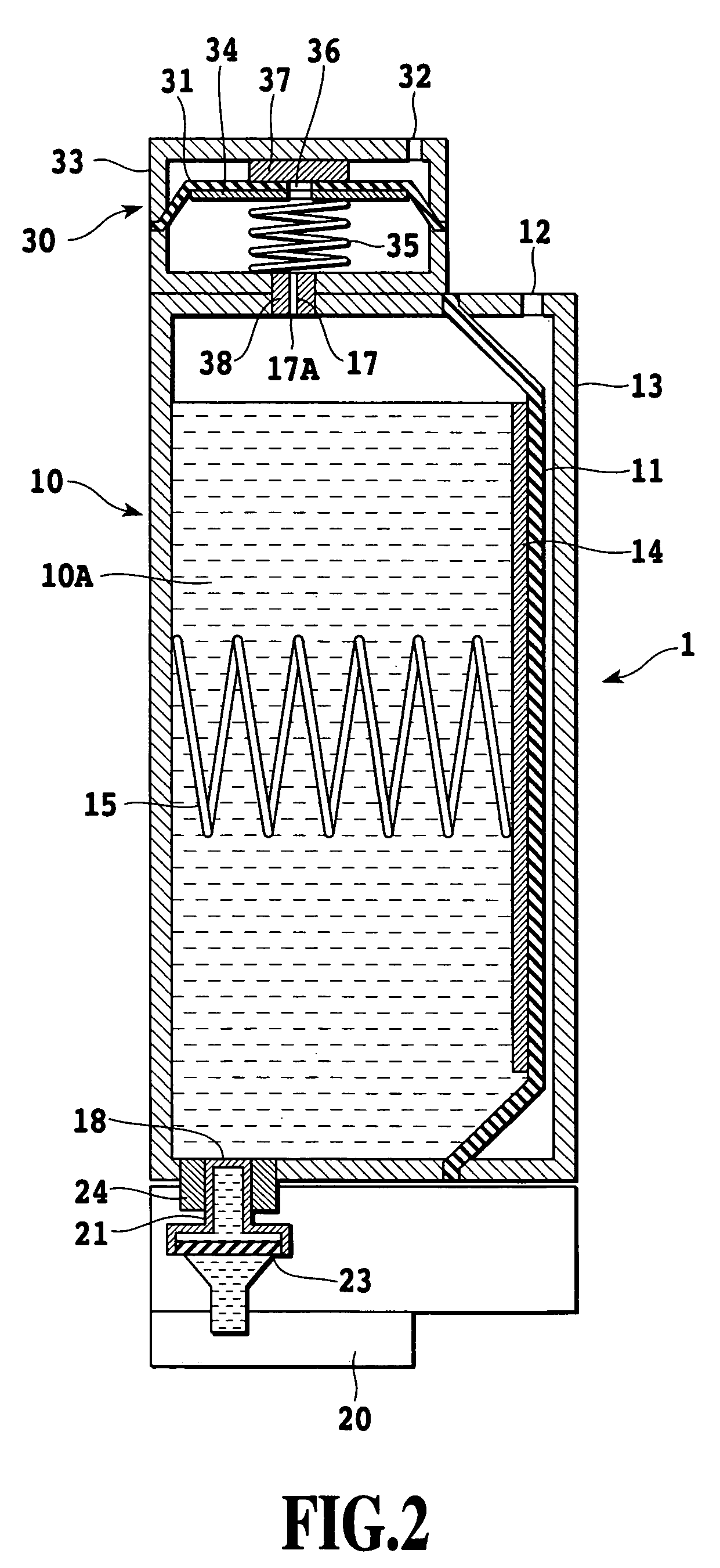Liquid container and ink jet printing apparatus
a liquid container and ink jet technology, applied in printing and other directions, can solve the problems of inability to supply ink to the printing head stably, inability to use the ink tank before the ink is completely used up, and increased negative pressur
- Summary
- Abstract
- Description
- Claims
- Application Information
AI Technical Summary
Benefits of technology
Problems solved by technology
Method used
Image
Examples
first embodiment
(First Embodiment)
[0050]FIG. 2 shows a liquid container in another embodiment of the invention, the liquid container having an ink jet printing head 20 (hereinafter simply referred to as “printing head) integrally mounted thereto. The liquid container (hereinafter also referred to as “ink container”) is generally constituted by two chambers, i.e., an ink containing chamber 10 in which an ink containing space 10A is defined and a valve chamber 30 positioned at an upper part of the ink containing chamber in a state of use as shown in this figure, and the interiors of the two chambers are in communication with each other through an air introduction channel 17. Ink to be ejected from the printing head 20 is charged in the ink containing chamber 10 and is supplied to the printing head 20. Here, the air introduction channel 17 in the state of use is positioned at an upper part of the ink containing chamber, whereby an air supply opening 17A for discharging air is also positioned upper par...
second embodiment
(Second Embodiment)
[0072]Although the first embodiment has a configuration in which the valve chamber is located higher than the ink containing chamber in the position or orientation in use, instead of relying upon the positional relationship between those elements, the same purpose can be achieved by appropriately configuring the air introduction channel.
[0073]FIG. 5 shows a liquid container used in a second embodiment of the invention. A printing head 20 similar to that in the first embodiment is integrally mounted to a liquid container 2. The liquid container (hereinafter also referred to as “ink container”) is generally comprised of three chambers, i.e., an ink containing chamber 40 in which an ink containing space 40A is defined, a valve chamber 30, and an air introduction channel containing chamber 50. The interiors of the ink containing chamber 40 and the valve chamber 30 are in communication with each other through an air introduction channel 51 provided in the air introduct...
third embodiment
(Third Embodiment)
[0092]FIG. 7 shows a liquid container used in a third embodiment of the invention. In the second embodiment shown in FIG. 5, the movable member for defining the ink containing space is formed with a side section substantially in the form of an isosceles trapezoid and is supported at a peripheral section of the same. A movable member 61 of the present embodiment is shaped to have a flat continuous portion in a top surface thereof, and an end of the portion is supported by a partition wall 73 in an upper part of a container 60. Further, a part of the movable member 61 on the right side thereof in the figure is not expanded and contracted or deformed by employing a support plate 64 configured to extend toward the partition wall 73.
[0093]An air introduction channel 71 is configured such that it is in communication with the upper part of the containing space in a part thereof in the vicinity of the position where the movable member is supported, and no tube is connected...
PUM
 Login to View More
Login to View More Abstract
Description
Claims
Application Information
 Login to View More
Login to View More - R&D
- Intellectual Property
- Life Sciences
- Materials
- Tech Scout
- Unparalleled Data Quality
- Higher Quality Content
- 60% Fewer Hallucinations
Browse by: Latest US Patents, China's latest patents, Technical Efficacy Thesaurus, Application Domain, Technology Topic, Popular Technical Reports.
© 2025 PatSnap. All rights reserved.Legal|Privacy policy|Modern Slavery Act Transparency Statement|Sitemap|About US| Contact US: help@patsnap.com



